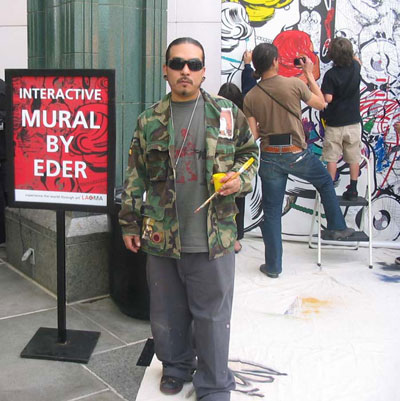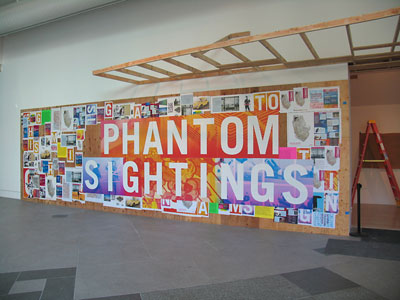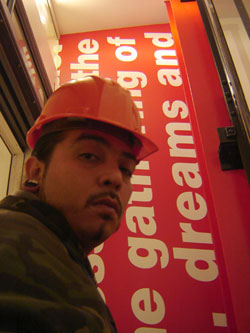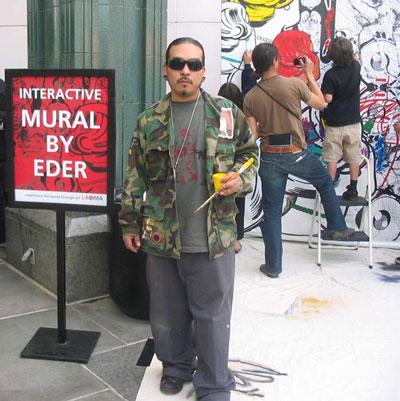
Eder Cetina has worked with LACMA both as an artist and fabricator. He's been a featured artist at our Late Night Art events, overseen installation of large-scale graphics pieces in our collection, and has created graphic elements for many LACMA exhibitions, such as the title wall to the recent Phantom Sightings exhibition, just to name a few. He's also built a vibrant following with the street art/hip hop scene around Los Angeles, recently appearing/painting at the Ludacris show at the L.A. Coliseum. We've worked on a number of projects together both at LACMA and around L.A.—here's a bit more about him.
How did you become a liaison for LACMA and other major museums here in Los Angeles, like the Getty and MOCA?
I had been working with Olson Visual managing large print and fabrication projects for Rodney Graham, John Baldessari, Sharon Lockhart, and the list goes on. All of a sudden, the more events and openings I attended, the smaller the art world became and I would just get in where I would fit in. I did small freelance projects here and there, just found myself working with designers, artists, and curators from all over the globe. My relationships with the California Association of Museums and the American Association of Museums and their many affiliates have really helped to further my goals and visions in the museum field.
You alternate your role as designer, fabricator, and artist. Is there a distinct line between them?
Yes—and I've crossed them all. As I see it, as a designer I collaborate. When I take the role of fabricator, I cooperate. And as an artist, I just create and do just what I please.

Title wall graphic for Phantom Sightings: Art after the Chicano Movement
What are some of the most memorable projects you've worked on at LACMA?
I would say that there are a few that stand out, like my very first show here at LACMA, Made in California—NOW, and Diane Arbus Revelations. I also had the honor of producing a hand-painted mural for the Dalí exhibit. More include working on Tim Hawkinson's first major museum survey, and Magritte and Contemporary Art in 2006. Mostly recently, I worked on most of the graphic elements for Art of Two Germanys/Cold War Cultures. It's really hard to pick just one because I've worked on almost every show at LACMA in the past five years.

With a detail of Untitled (Shafted), 2008, by Barbara Kruger
What has been the most difficult install, either here or within your professional career?
By far, Barbara Kruger's Shafted [a three-story-high artwork installed in BCAM's elevator shaft], which we worked on for three weeks straight, day and night, practically living inside of BCAM. From pre-press to install, it was by far one of the most challenging and satisfying installations. And as a bonus, it was great to see new pieces of art from the Broad Foundation arrive daily before the grand opening.
I have seen you act as a curator, artist, and organizer for both traditional art shows and freeform "intervention" installs/projects. What draws you to these projects?
I just feel the need to creatively express myself whether as an artist creating a new piece or a curator working with an up-and-coming artist. I just have a passion for creative expression and the arts.
Do you collect art from your peers, or more established artists?
Yeah, I got a nice li'l collection. I'm really into street art... I just picked up a Fafi painting and another Barry McGee piece.
Does Los Angeles influence your work?
F**k yeah! The complexity of glamour and dirt—it's like a love/hate relationship. The further I try to get away, the closer it pulls me in.
You worked on some of the largest projects LACMA has ever produced, but some of your contributions have ultimately been scrapped once the shows are over. Is that hard to deal with?
It's sad for a minute, but then I get too busy on the next project to really dwell on it. That's why documenting every project has become so important to me. I've also partnered up with a couple of great recycling companies to try to reuse most of the waste materials these large exhibits produce.
Paul Wehby, Graphic Designer



